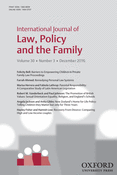-
Views
-
Cite
Cite
Angela Jackson, Anita Gibbs, New Zealand’s Home for Life Policy: Telling Children they Matter but only for Three Years, International Journal of Law, Policy and the Family, Volume 30, Issue 3, December 2016, Pages 322–337, https://doi.org/10.1093/lawfam/ebw007
Close - Share Icon Share
Abstract
In Aotearoa/New Zealand, finding a permanent home for a child, outside of the birth parent’s care, generally occurs in the most severe cases of abuse and/or neglect. In these instances, significant care and protection concerns persist, making reunification between the child and their birth parents contrary to the child’s best interests. Thus, social work efforts become centred on establishing permanent care arrangements with either whānau (extended family) or non-whānau caregivers. Creating a stable and permanent home can assist a child in recovering from the damaging effects of being exposed to abuse and/or neglect. Permanency in New Zealand is predominantly achieved through long-term fostering rather than adoption, ideally through the government’s 2010 policy, Home for Life . This policy aims to support foster parents to permanently care for a child, by providing a range of supports from financial to respite care. While the policy emphasizes the importance of permanency and is designed to reach this outcome, there are significant limitations that have the ability to prevent this from occurring. This article will explore Home for Life and its limitations in achieving permanency, specifically the insufficient legal protection caregivers are afforded and the absence of post-permanency support. It will conclude by proposing changes to the policy.




